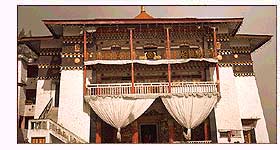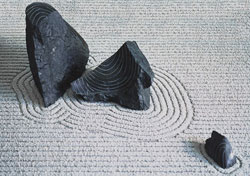Wednesday, November 29, 2006
I'm Moving
Namaste!
GeekZenDaddy
http://geekzendaddyzen.wordpress.com
Saturday, November 18, 2006
India should return Tawang to China
OK, this confuses me, but I'm not a super genius or even a mapmaker for that matter. China wants a Buddhist town back from India that is important to Tibetan Buddhists. As expected, they don't want to hand it over to China. HHuuummmm well how about this, if China gave Tibet back to the Tibetans, they could leave India and be able to go home. Yeah, I don't see that happening either.......
Zee News, Nov 15, 2006
Beijing, China -- Amid the heat generated by the latest Chinese claim of sovereignty over entire Arunachal Pradesh, prominent scholars here have backed Beijing's claim over Tawang, a strategic Buddhist town nestled in the Himalayas.

<< Tawang monastery
Speaking at the first-ever seminar on the 1962 India-China war and the boundary issue, held ahead of Chinese President Hu Jintao's maiden state visit to India from November 20, prominent Chinese scholars on South Asia voiced their firm support for Beijing's stand that India should return Tawang to China as part of the final settlement.
"India entered into Tawang, the birthplace of the sixth Dalai Lama, in 1951. For Tibetan Buddhism Tawang is important," the Deputy Director of the Institute of Asia-Pacific studies of the Chinese Academy of Social Sciences, Professor Sun Shihai said.
"In the negotiations for the settlement of the boundary issue, both countries should be sensitive to the national sentiments of each side," sun said.
Sun, who presided over the seminar, told here that Chinese scholars were of the view that both India and China should be willing to make 'adjustments' in the eastern and Western sectors of the disputed boundary for the final settlement of the border dispute.
"The McMohan Line, drawn by British is illegal. Successive Chinese governments have not accepted it. There is no question of the current socialist government accepting it as well. But we can discuss and make adjustments," he said.
The Free Buddhist Encyclopedia Project

While reading posts on another site, I saw mention of the Buddhist Encyclopedia. I surfed on over and was impressed. They have not been up for very long but have had over 1700 articles submitted. The BEP is in Wikipedia format so anyone with an account is able to submit or edit articles (within reason). After poking around, there is indeed a lot of good information. Why not wander over and check it out? http://buddhism.2be.net/Main_Page
Thursday, November 16, 2006
Buddha Quote
 Subhuti asked the Buddha: "The highest, most awakened mind that you have attained - is that mind the unattainable?"
Subhuti asked the Buddha: "The highest, most awakened mind that you have attained - is that mind the unattainable?""Yes, Subhuti. With regard to that highest and most awakened mind, I have
not attained anything. That mind is everywhere equally. It cannot be
attained or grasped, but it can be realized. It is realized through the
practice of all good actions when they are done in the spirit of no self and
no object of self."
- Prajnaparamita
Wednesday, November 15, 2006
This Week's Words of Wisdom by Master Sheng Yen
 Whatever the circumstance, when you feel that you are suffering, remind yourself of this: "In this world there are many more people and situations that are worst than mine, so this is nothing." If you think along this way you will not blame others and more often, you will only think of the multitude of people who suffer and need our help.
Whatever the circumstance, when you feel that you are suffering, remind yourself of this: "In this world there are many more people and situations that are worst than mine, so this is nothing." If you think along this way you will not blame others and more often, you will only think of the multitude of people who suffer and need our help.
Tuesday, November 14, 2006
Zen Gardens
By MANNY BALDEMOR, ABS-CBN, Nov 13, 2006
If there was a moment of absolute clarity where one can perceive the nothingness and unity of all things, and at the same time gain positive enlightenment as a result, that period is Zen.
 Manila, Philippines -- Zen Buddhism is one of the foundations of the Japanese culture. In A.D. 794 Japan's capital shifted from Narra to Kyoto, and for more than a thousand years remained as the center of government. Although Tokyo is the present capital of the country, it cannot be denied that much of old Japan remains in Kyoto, which to this day is clearly the major cultural center of Japan.
Manila, Philippines -- Zen Buddhism is one of the foundations of the Japanese culture. In A.D. 794 Japan's capital shifted from Narra to Kyoto, and for more than a thousand years remained as the center of government. Although Tokyo is the present capital of the country, it cannot be denied that much of old Japan remains in Kyoto, which to this day is clearly the major cultural center of Japan.
Buddhism came to Japan in the 6th century initially competing with existing Shinto beliefs, Japan's native religion. The former was originally passed on from Korea, and later from China. After hundreds of years, Zen Buddhism was established as a complex form of Buddhism particularly favored by the military class and was Japan's distinctive contribution to the religion.
Zen is a shortened form of Zenna from the Sanskrit term "dhyânam," which means meditation or contemplation. One of the central practices of Zen is Zazen, which means to meditate in a sitting position. Another is through Koan, the telling of certain stories and anecdotes (e.g. if a leaf falls inside a forest, does it make a sound?) pertaining to Zen and meditating on the deep questions and answers they elicit. Zen Buddhism involves introspective meditation, and through a disciplined simple lifestyle, a person can let go of worldly desires and achieve enlightenment, which is the main goal of Buddhism in general. By calming the mind, sitting meditation and emptying one's self, a person can dispel and discover self-knowledge.
Zen gardens are designed for practitioners of Zen to induce contemplation and meditation. The garden is both a philosophical statement and an object of aesthetic appreciation. Japanese gardens aim to imitate nature and the Holy Land for Zen garden enthusiasts are still in Kyoto, which has hundreds of Buddhist temples and monasteries. Everything is simplified and distractions are eliminated.
The dry garden of Roanji in Kyoto is the best example of a Zen garden (created in 1500 by Soami). The main elements comprise of rocks and sand—the sea is symbolized by furrows in a layer of sand suggesting ripples; rocks suggestive of a waterfall; and 15 stones forming islands in a sea of raked pebbles. A true haven for one's personal search for tranquility.
What is your moment of Zen?
Tuesday, November 07, 2006
Zen Quote of the Day

If I am holding a cup of water and I ask you, "is the cup empty?" you will say "No, it is full of water." But if i pour out the water and I ask you again, you may say, "yes, it is empty." but, empty of what?....My cup is empty of water, but it is not empty of air. To be empty is to be empty of something..... When Avalokita [Kuan-Yin, or Kannon, the bodhisattva who embodies Compassion] says [in the Heart Sutra] that the five skandas are equally empty, to help him be precise, we must ask "Mr. Avolikta, empty of what?" The five Skandas, which may be translated into english as the five heaps, or five aggregates, are the five elements of that comprise the human being.....In fact, these are really five rivers flowing together in us: the river of form, which means our body, the river of mental formations, the river of feelings, the river of perceptions and the river of consciousness. They are always flowing within us... Arvalokit looked deeply into the five skhandas... and discovered none of them can be by itself alone....Form is empty of a separate self, but it is full of everything else in the cosmos. The same is true with feelings, perceptions, mental formations, and consciousness.
Thich Nat Hanh
The Heart of Understanding







